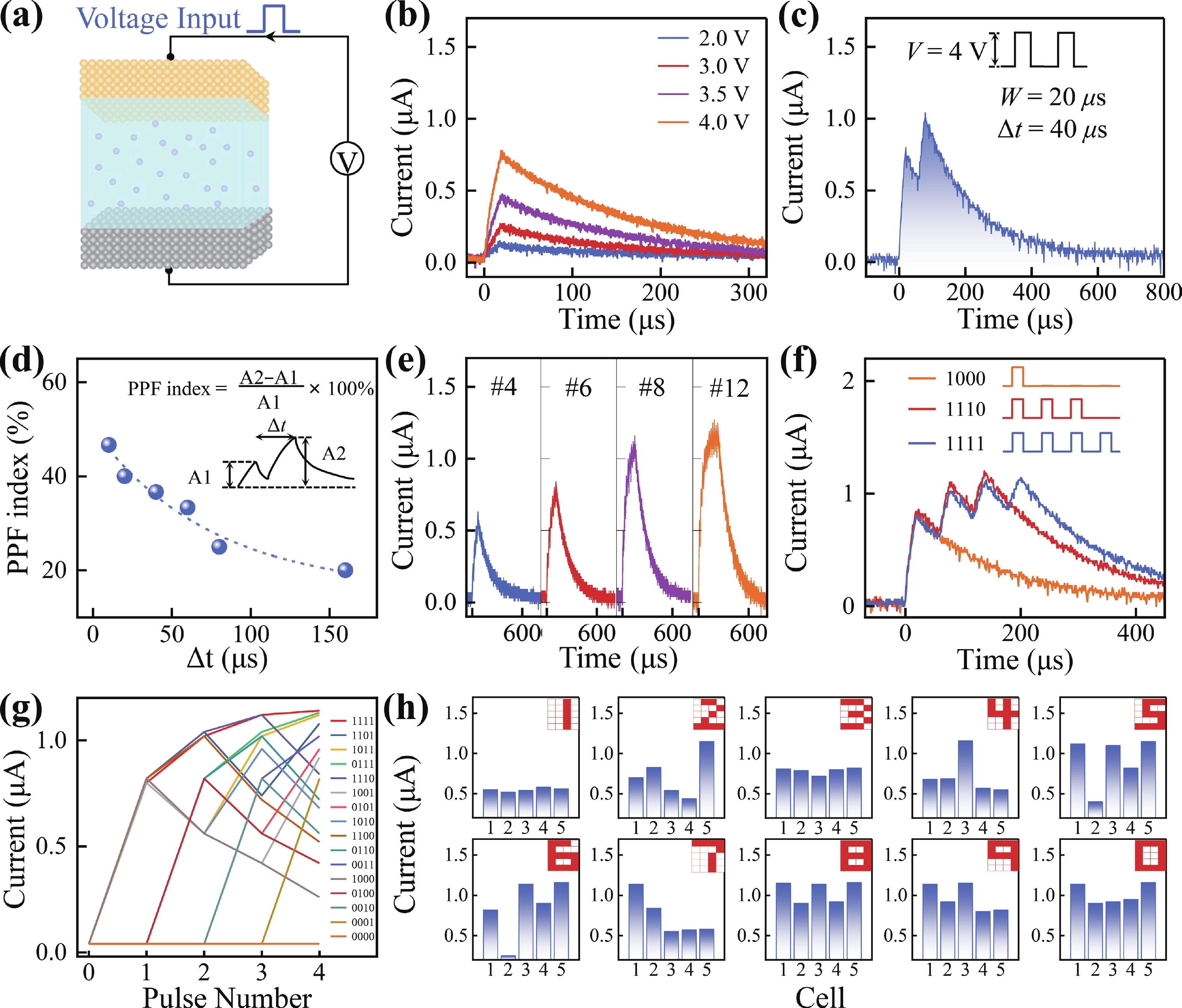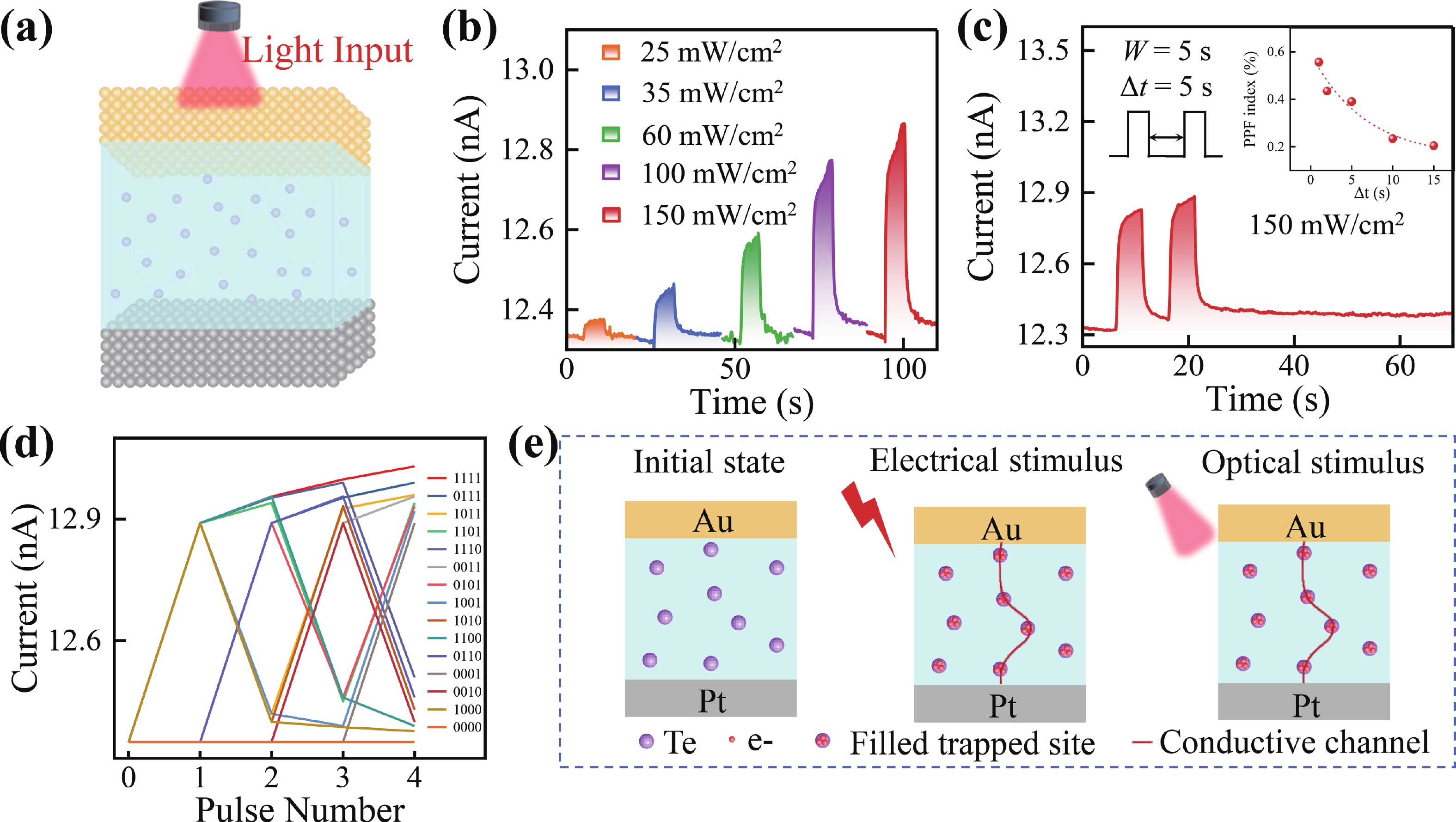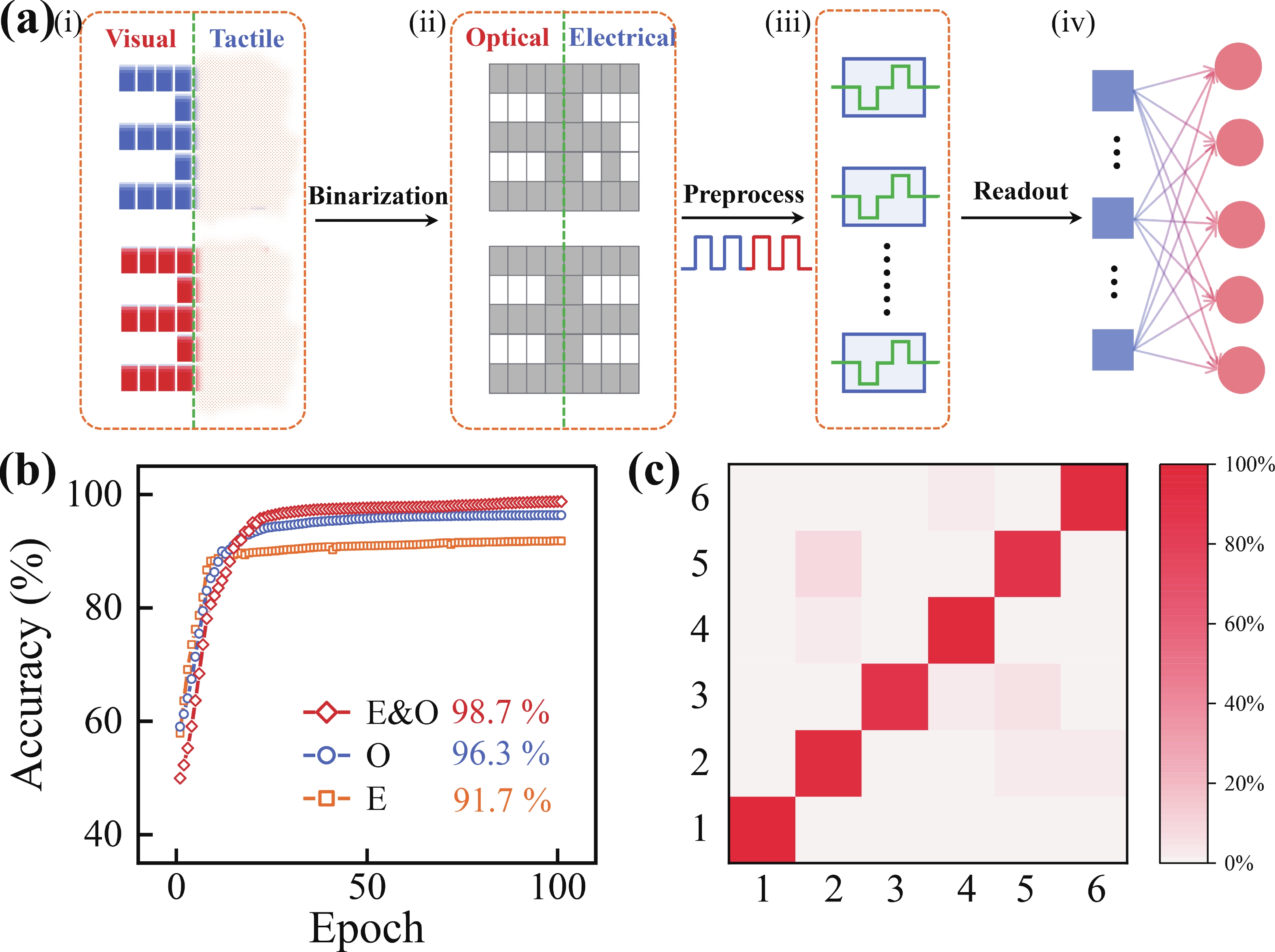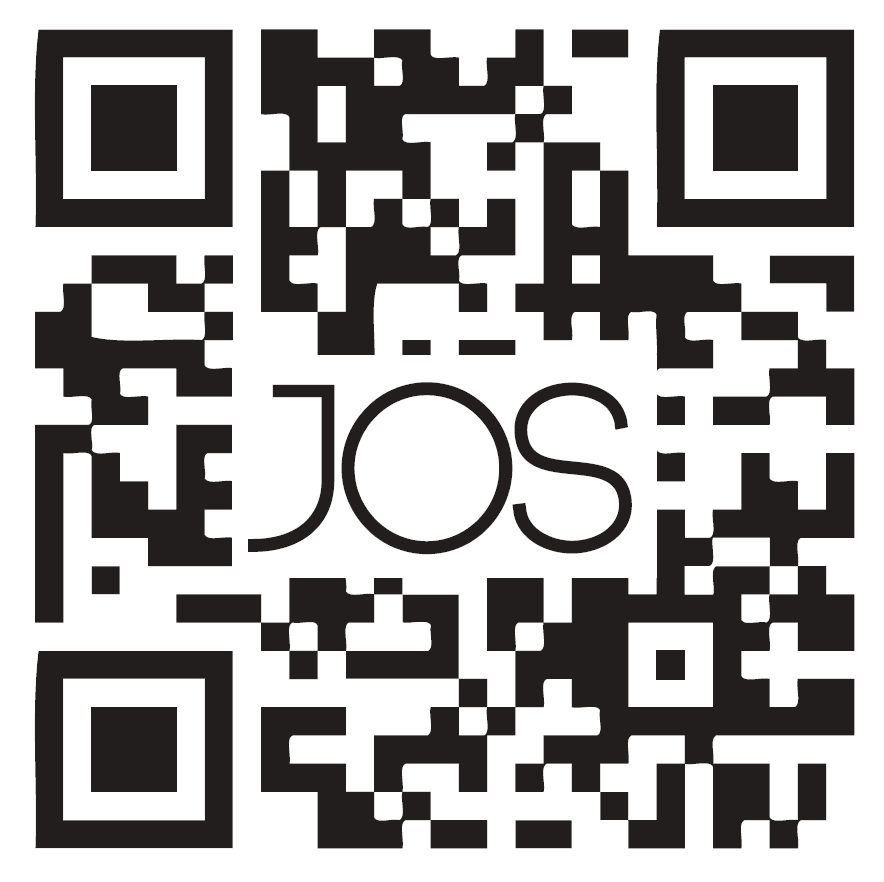| Citation: |
Qiaoling Tian, Kuo Xun, Zhuangzhuang Li, Xiaoning Zhao, Ya Lin, Ye Tao, Zhongqiang Wang, Daniele Ielmini, Haiyang Xu, Yichun Liu. Optoelectronic memristor based on a-C:Te film for muti-mode reservoir computing[J]. Journal of Semiconductors, 2025, 46(2): 022407. doi: 10.1088/1674-4926/24100008
****
Q L Tian, K Xun, Z Z Li, X N Zhao, Y Lin, Y Tao, Z Q Wang, D Ielmini, H Y Xu, and Y C Liu, Optoelectronic memristor based on a-C:Te film for muti-mode reservoir computing[J]. J. Semicond., 2025, 46(2), 022407 doi: 10.1088/1674-4926/24100008
|
Optoelectronic memristor based on a-C:Te film for muti-mode reservoir computing
DOI: 10.1088/1674-4926/24100008
CSTR: 32376.14.1674-4926.24100008
More Information-
Abstract
Optoelectronic memristor is generating growing research interest for high efficient computing and sensing-memory applications. In this work, an optoelectronic memristor with Au/a-C:Te/Pt structure is developed. Synaptic functions, i.e., excitatory post-synaptic current and pair-pulse facilitation are successfully mimicked with the memristor under electrical and optical stimulations. More importantly, the device exhibited distinguishable response currents by adjusting 4-bit input electrical/optical signals. A multi-mode reservoir computing (RC) system is constructed with the optoelectronic memristors to emulate human tactile-visual fusion recognition and an accuracy of 98.7% is achieved. The optoelectronic memristor provides potential for developing multi-mode RC system. -
References
[1] Sun Z H, Feng Y, Guo P, et al. Flash-based in-memory computing for stochastic computing in image edge detection. J Semicond, 2023, 44, 054101 doi: 10.1088/1674-4926/44/5/054101[2] Shastri B J, Tait A N, Ferreira de Lima T, et al. Photonics for artificial intelligence and neuromorphic computing. Nat Photonics, 2021, 15, 102 doi: 10.1038/s41566-020-00754-y[3] Hao Y X, Zhang Y, Wu Z H, et al. Uniform, fast, and reliable CMOS compatible resistive switching memory. J Semicond, 2022, 43, 054102 doi: 10.1088/1674-4926/43/5/054102[4] Yan M, Huang C, Bienstman P, et al. Emerging opportunities and challenges for the future of reservoir computing. Nat Commun, 2024, 15, 2056 doi: 10.1038/s41467-024-45187-1[5] Xiang S Y, Han Y N, Song Z W, et al. A review: Photonics devices, architectures, and algorithms for optical neural computing. J Semicond, 2021, 42, 023105 doi: 10.1088/1674-4926/42/2/023105[6] Zuo W B, Zhu Q H, Fu Y Y, et al. Volatile threshold switching memristor: An emerging enabler in the AIoT era. J Semicond, 2023, 44, 053102 doi: 10.1088/1674-4926/44/5/053102[7] Xin K Y, Wang X G, Grove-Rasmussen K, et al. Twist-angle two-dimensional superlattices and their application in (opto)electronics. J Semicond, 2022, 43, 011001 doi: 10.1088/1674-4926/43/1/011001[8] Deng Y F, Li Y X, Wang P F, et al. Observation of resistive switching in a graphite/hexagonal boron nitride/graphite heterostructure memristor. J Semicond, 2022, 43, 052003 doi: 10.1088/1674-4926/43/5/052003[9] Zhang S Q, Song B, Jia S J, et al. Multilayer doped-GeSe OTS selector for improved endurance and threshold voltage stability. J Semicond, 2022, 43, 104101 doi: 10.1088/1674-4926/43/10/104101[10] Gao Z M, Lyu S X, Lyu H B. Frequency dependence on polarization switching measurement in ferroelectric capacitors. J Semicond, 2022, 43, 014102 doi: 10.1088/1674-4926/43/1/014102[11] Li Y J, Tang J S, Gao B, et al. Oscillation neuron based on a low-variability threshold switching device for high-performance neuromorphic computing. J Semicond, 2021, 42, 064101 doi: 10.1088/1674-4926/42/6/064101[12] Sun Y M, Song C, Yin S Q, et al. Design of a controllable redox-diffusive threshold switching memristor. Adv Electron Mater, 2020, 6, 2000695 doi: 10.1002/aelm.202000695[13] Teja Nibhanupudi S S, Roy A, Veksler D, et al. Ultra-fast switching memristors based on two-dimensional materials. Nat Commun, 2024, 15, 2334 doi: 10.1038/s41467-024-46372-y[14] Cheng Z G, Ríos C, Pernice W H P, et al. On-chip photonic synapse. Sci Adv, 2017, 3, e1700160 doi: 10.1126/sciadv.1700160[15] Xu M J, Xu T F, Yu A Q, et al. Optoelectronic synapses based on photo-induced doping in MoS2/h-BN field-effect transistors. Adv Optical Mater, 2021, 9, 2100937 doi: 10.1002/adom.202100937[16] Li R L, Lin Y H, Li Y, et al. Amorphous gallium oxide homojunction-based optoelectronic synapse for multi-functional signal processing. J Semicond, 2023, 44, 074101 doi: 10.1088/1674-4926/44/7/074101[17] Fang Y Q, Meng J L, Li Q X, et al. Two-terminal photoelectric dual modulation synaptic devices for face recognition. IEEE Electron Device Lett, 2023, 44, 241 doi: 10.1109/LED.2022.3228944[18] Lin Y H, Wang W X, Li R L, et al. Multifunctional optoelectronic memristor based on CeO2/MoS2 heterojunction for advanced artificial synapses and bionic visual system with nociceptive sensing. Nano Energy, 2024, 121, 109267 doi: 10.1016/j.nanoen.2024.109267[19] Song J R, Meng J L, Wang T Y, et al. InGaZnO-based photoelectric synaptic devices for neuromorphic computing. J Semicond, 2024, 45, 092402 doi: 10.1088/1674-4926/24040038[20] Liu K Q, Zhang T, Dang B J, et al. An optoelectronic synapse based on α-In2Se3 with controllable temporal dynamics for multimode and multiscale reservoir computing. Nat Electron, 2022, 5, 761 doi: 10.1038/s41928-022-00847-2[21] Ai L, Pei Y F, Song Z Q, et al. Ligand-triggered self-assembly of flexible carbon dot nanoribbons for optoelectronic memristor devices and neuromorphic computing. Adv Sci, 2023, 10, 2207688 doi: 10.1002/advs.202207688[22] Xu J Q, Wang X F, Zhao X N, et al. Light-controlled stateful reconfigurable logic in a carbon dot-based optoelectronic memristor. Appl Phys Lett, 2024, 124, 073507 doi: 10.1063/5.0181090[23] Cao G, Cheng C T, Zhang H J, et al. The application of halide perovskites in memristors. J Semicond, 2020, 41, 051205 doi: 10.1088/1674-4926/41/5/051205[24] Lu B J, Du J G, Lu J G, et al. Ultralow operating voltage Nb2O5-based multilevel resistive memory with direct observation of Cu conductive filament. ACS Materials Lett, 2023, 5, 1350 doi: 10.1021/acsmaterialslett.2c01218[25] Lu B J, Hu D N, Yang R Q, et al. Self-repairable, high-uniform conductive-bridge random access memory based on amorphous NbSe2. SmartMat, 2024, 5, e1240 doi: 10.1002/smm2.1240[26] Lu B J, Hu D N, Wu M, et al. Low-operation voltage conductive-bridge random access memory based on amorphous NbS2. Smart Mol, 2023, 1, e20230008 doi: 10.1002/smo.20230008[27] Zhuge F, Dai W, He C L, et al. Nonvolatile resistive switching memory based on amorphous carbon. Appl Phys Lett, 2010, 96, 163505 doi: 10.1063/1.3406121[28] Chai Y, Wu Y, Takei K, et al. Nanoscale bipolar and complementary resistive switching memory based on amorphous carbon. IEEE Trans Electron Devices, 2011, 58, 3933 doi: 10.1109/TED.2011.2164615[29] Amani M, Tan C L, Zhang G, et al. Solution-synthesized high-mobility tellurium nanoflakes for short-wave infrared photodetectors. ACS Nano, 2018, 12, 7253 doi: 10.1021/acsnano.8b03424[30] Shen Q C, Luo Z, Ma S, et al. Bioinspired infrared sensing materials and systems. Adv Mater, 2018, 30, 1707632 doi: 10.1002/adma.201707632[31] Zha J J, Shi S H, Chaturvedi A, et al. Electronic/optoelectronic memory device enabled by tellurium-based 2D van der waals heterostructure for in-sensor reservoir computing at the optical communication band. Adv Mater, 2023, 35, 2211598 doi: 10.1002/adma.202211598[32] Wu W Z, Qiu G, Wang Y X, et al. Tellurene: Its physical properties, scalable nanomanufacturing, and device applications. Chem Soc Rev, 2018, 47, 7203 doi: 10.1039/C8CS00598B[33] Shen J B, Jia S J, Shi N N, et al. Elemental electrical switch enabling phase segregation-free operation. Science, 2021, 374, 1390 doi: 10.1126/science.abi6332[34] Carotenuto G, Palomba M, De Nicola S, et al. Structural and photoconductivity properties of tellurium/PMMA films. Nanoscale Res Lett, 2015, 10, 1007 doi: 10.1186/s11671-015-1007-z[35] Ye B R, Gong C, Huang M L, et al. Improved performance of a CoTe//AC asymmetric supercapacitor using a redox additive aqueous electrolyte. RSC Adv, 2018, 8, 7997 doi: 10.1039/C7RA12919J[36] Ayiania M, Smith M, Hensley A J R, et al. Deconvoluting the XPS spectra for nitrogen-doped chars: An analysis from first principles. Carbon, 2020, 162, 528 doi: 10.1016/j.carbon.2020.02.065[37] Zeng T, Yang Z, Liang J B, et al. Flexible and transparent memristive synapse based on polyvinylpyrrolidone/N-doped carbon quantum dot nanocomposites for neuromorphic computing. Nanoscale Adv, 2021, 3, 2623 doi: 10.1039/D1NA00152C[38] Wang W H, Zhou G D, Wang Y C, et al. Multiphotoconductance levels of the organic semiconductor of polyimide-based memristor induced by interface charges. J Phys Chem Lett, 2022, 13, 9941 doi: 10.1021/acs.jpclett.2c02651[39] Wang X M, Yang F, Liu Q, et al. Neuromorphic circuits based on memristors: Endowing robots with a human-like brain. J Semicond, 2024, 45, 061301 doi: 10.1088/1674-4926/23120037[40] Wen W, Guo Y L, Liu Y Q. Multifunctional neurosynaptic devices for human perception systems. J Semicond, 2022, 43, 051201 doi: 10.1088/1674-4926/43/5/051201[41] Wang J J, Pan X Q, Zhao Z B, et al. An infrared near-sensor reservoir computing system based on large-dynamic-space memristor with tens of thousands of states for dynamic gesture perception. Adv Sci, 2024, 11, 2307359 doi: 10.1002/advs.202307359[42] Sun L F, Wang R Z, Jiang J B, et al. In-sensor reservoir computing for language learning via two-dimensional memristors. Sci Adv, 2021, 7, eabg1455 doi: 10.1126/sciadv.abg1455 -
Proportional views





 Qiaoling Tian got her B.S. degree at Hebei Normal University of Science and Technology in 2018, Qinhuangdao China, and Ph.D. degree at Northeast Normal University in 2024, Changchun, China. Her current research focuses on fabrication and electrical characterization of memristive devices.
Qiaoling Tian got her B.S. degree at Hebei Normal University of Science and Technology in 2018, Qinhuangdao China, and Ph.D. degree at Northeast Normal University in 2024, Changchun, China. Her current research focuses on fabrication and electrical characterization of memristive devices. Xiaoning Zhao received his B.S. degree at Dalian University of Technology in 2011, Dalian, China, and Ph.D. degree at Northeast Normal University in 2016, Changchun, China. He is currently a professor at Northeast Normal University, China. His research interest includes the fabrication, characterization, and application of memristor.
Xiaoning Zhao received his B.S. degree at Dalian University of Technology in 2011, Dalian, China, and Ph.D. degree at Northeast Normal University in 2016, Changchun, China. He is currently a professor at Northeast Normal University, China. His research interest includes the fabrication, characterization, and application of memristor.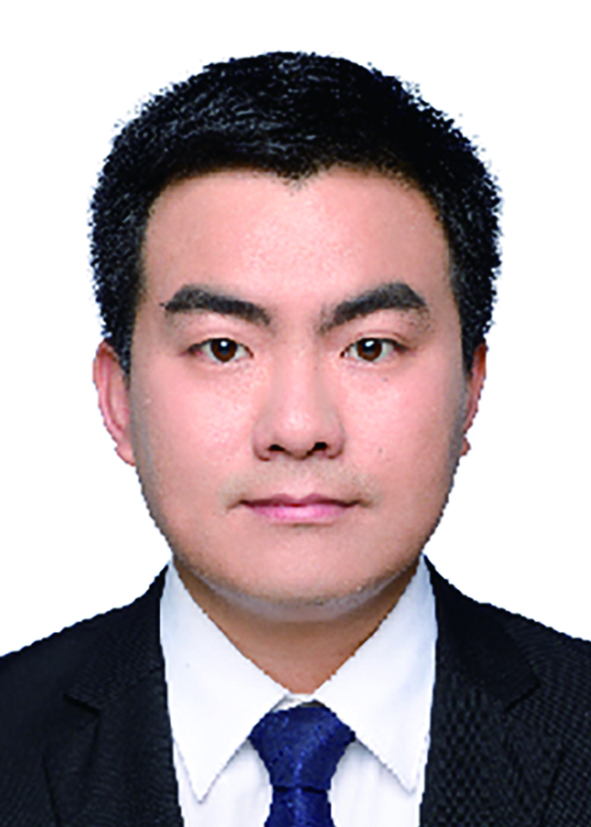 Zhongqiang Wang received the B.S. and Ph.D. degrees in 2008 and 2013 at Northeast Normal University, Changchun, China. During 2014–2016, he worked as a postdoctoral fellow in Polytechnic University of Milan, Italy. Currently, he is a professor at Northeast Normal University. His current research interests include device fabrication, electrical characterization, and neuromorphic applications of memristor.
Zhongqiang Wang received the B.S. and Ph.D. degrees in 2008 and 2013 at Northeast Normal University, Changchun, China. During 2014–2016, he worked as a postdoctoral fellow in Polytechnic University of Milan, Italy. Currently, he is a professor at Northeast Normal University. His current research interests include device fabrication, electrical characterization, and neuromorphic applications of memristor.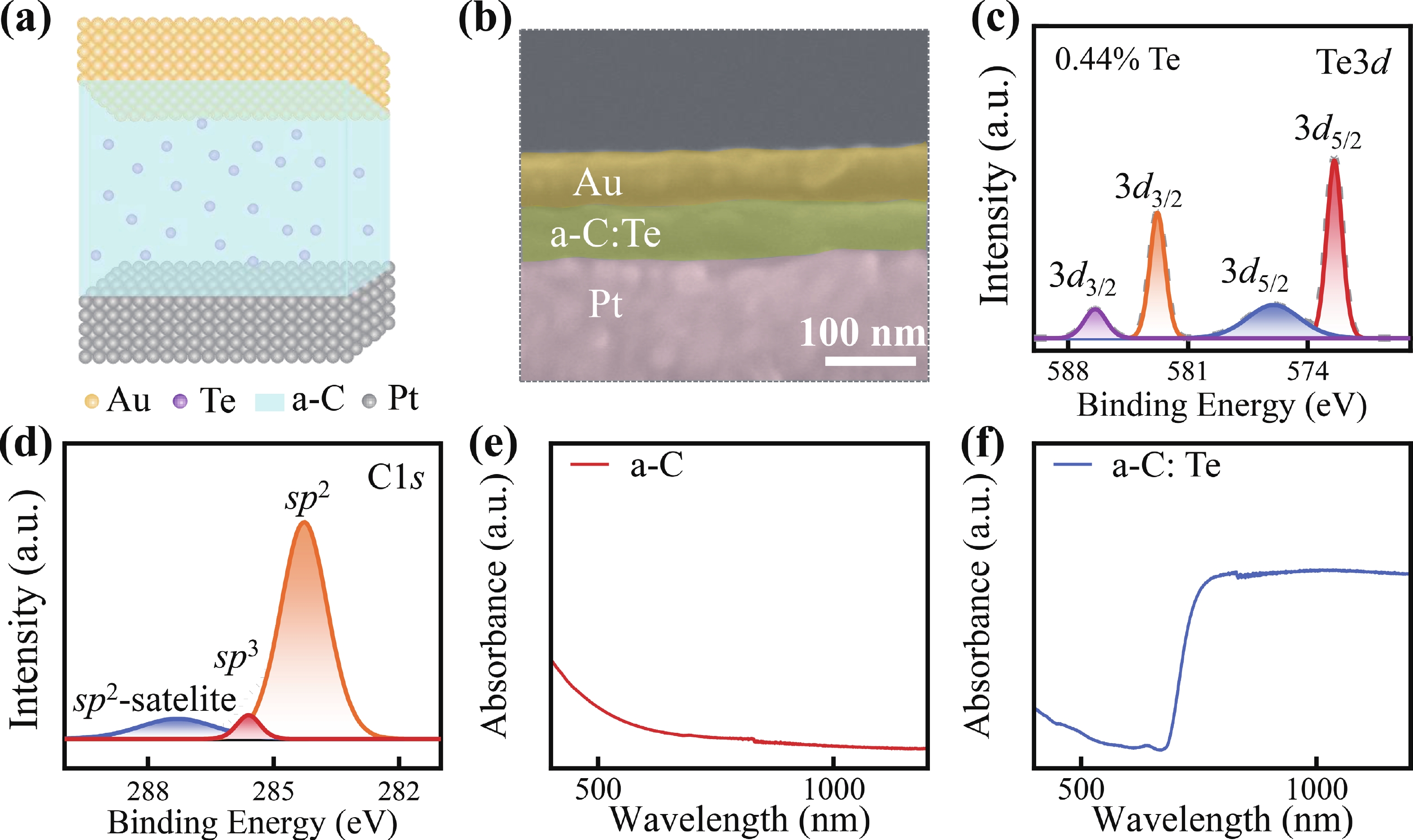
 DownLoad:
DownLoad:
